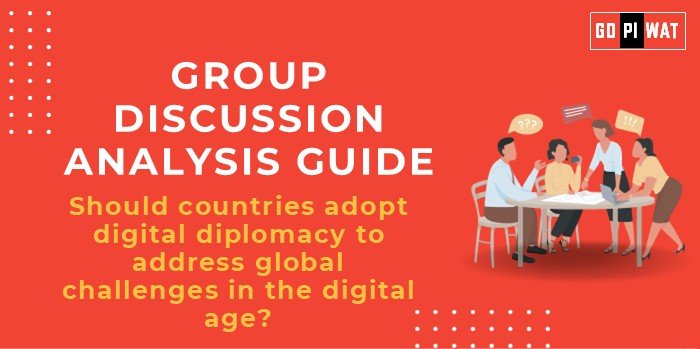📋 Group Discussion (GD) Analysis Guide
🌐 Should Countries Adopt Digital Diplomacy to Address Global Challenges in the Digital Age?
💻 Introduction to Digital Diplomacy
Opening Context: In an interconnected world, traditional diplomacy is evolving to include digital tools and platforms, enabling nations to address global challenges such as cybersecurity, climate change, and public health with greater efficiency.
Topic Background: Digital diplomacy involves leveraging digital technologies for international relations, negotiation, and communication. Originating with the rise of social media in the early 2000s, it now encompasses AI, blockchain, and big data. Nations like Estonia and Singapore lead by integrating digital governance into their diplomatic strategies.
📊 Quick Facts and Key Statistics
- 🌍 Global Internet Users: Over 5.16 billion (2024) – Highlights the extensive reach of digital platforms.
- 🔐 Cybersecurity Threats: $10.5 trillion projected global cost by 2025 – Reflects the urgent need for international collaboration.
- 🌱 Climate Data Sharing: 100+ countries use satellite technology to monitor emissions – Digital tools enable global cooperation.
- 🏆 UN E-Government Index (2023): Estonia ranked #1 – Showcases effective digital diplomacy practices.
👥 Stakeholders and Their Roles
- 🏛️ Governments: Develop policies, represent national interests, and engage in multilateral negotiations.
- 🌐 International Organizations: Facilitate cooperation and set digital governance standards (e.g., UN, WTO).
- 💻 Tech Companies: Provide tools and platforms for communication and data-sharing (e.g., Google, Microsoft).
- 👥 Citizens and NGOs: Advocate for transparency and ethical practices in digital diplomacy.
🏆 Achievements and Challenges
🌟 Achievements:
- ✅ Efficient Communication: Real-time collaboration during crises (e.g., COVID-19 pandemic).
- 📈 Conflict Prevention: AI tools predicting geopolitical risks.
- 🤝 Cultural Exchange: Virtual platforms promoting mutual understanding.
⚠️ Challenges:
- 🔐 Cybersecurity Risks: Rising cyber-attacks targeting government systems.
- 📉 Digital Divide: Unequal access to digital tools, especially in developing nations.
Global Comparisons:
- ✅ Estonia: Leads in e-governance and digital diplomacy with secure, transparent digital infrastructure.
- 🌐 China: Leverages digital platforms for Belt and Road Initiative diplomacy.
Case Study: The UN’s Global Pulse initiative employs AI and big data to analyze humanitarian trends, demonstrating digital diplomacy’s potential.
✨ Structured Arguments for Discussion
- 💬 Supporting Stance: “Digital diplomacy allows nations to address global challenges more effectively, promoting real-time cooperation and innovation.”
- ⚖️ Opposing Stance: “Reliance on digital diplomacy risks exacerbating inequalities due to the digital divide and cyber vulnerabilities.”
- 🔄 Balanced Perspective: “While digital diplomacy enhances efficiency, its success hinges on addressing cybersecurity and inclusivity concerns.”
🎯 Effective Discussion Approaches
- 📖 Opening Strategies:
- Use impactful statistics: “With over 5 billion internet users, digital diplomacy is no longer optional—it’s essential.”
- Highlight a case study: “The UN’s use of AI for humanitarian forecasting exemplifies digital diplomacy’s potential.”
- 🔄 Counter-Argument Handling: Example: “While cyber risks are valid, adopting blockchain can enhance security.”
📈 Strategic Analysis of Strengths and Weaknesses
- 💪 Strengths: Real-time collaboration, cost-efficiency, broad reach.
- ⚠️ Weaknesses: Cybersecurity threats, reliance on technology.
- 💡 Opportunities: Bridging digital divides, fostering innovation.
- 🚨 Threats: Misinformation, regulatory fragmentation.
📚 Connecting with B-School Applications
- 🌟 Real-World Applications:
- Business strategies in international markets; digital transformation in operations.
- 💬 Sample Interview Questions:
- “How can digital diplomacy mitigate cybersecurity risks?”
- “What role can technology companies play in global diplomacy?”
- 📖 Insights for B-School Students:
- Explore technology-driven decision-making.
- Consider ethical dimensions of digital strategies.


